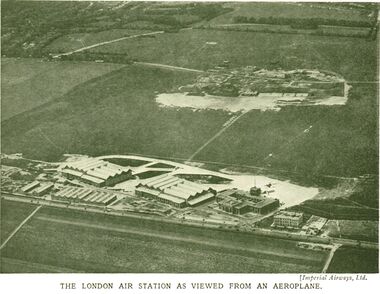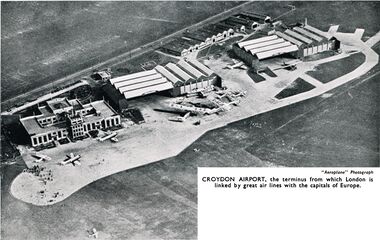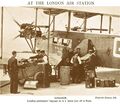Category:Croydon Airport
Croydon Airport coordinates: 51.356389, -0.117222
1928: "London Air Station", Croydon [image info]
1938: Croydon Airport [image info]
Croydon Airport, London Air Station. Croydon Airport was created from the merging of the Beddington (1915-) and Waddington (1918) airfields, in March 1920, and became the main base of operations for Imperial Airways. The airport was expanded after the start of the public Inquiry into the 1924 de Havilland DH.34 crash (Imperial's first fatal accident), the expansion giving the airport longer runways, and the world's first purpose-designed airport Control Tower, Terminus, and Hotel, with the new building commencing operations in 1928.
At this point the airport had almost every facility expected of an airport, except for (for obvious reasons) its inability to accommodate seaplanes and flying boats.
Visual recognition
Croydon's most distinctive feature was its square aircraft Control Tower, with railings and a central aerial: photographers taking a photo of an aircraft at Croydon would often try to get the Control Tower "in shot", and artists would often try to squeeze it into the corner of an aeroplane painting, due to the Tower's recognition factor.
Commercial flight
Between the Wars, Croydon Airport (styled "London Air Station", to match London's main railway terminus stations) was London's main commercial airport, and the main base for Imperial Airways. The central Hall of the airport building looked very like the interior of a railway station, with wooden benches, arrival-departure indicators, and a main clock. Since Croydon was so strongly set up for commercial air traffic, private flyers tended to use the more enthusiast-friendly services at Heston.
London's Air Port, 1934
Such is the development of aircraft in recent years that only three years separate the statement, made to the Wright Brothers in 1912 by a Cabinet Minister, that "His Majesty's Navies had no use for aeroplanes" from the first utilisation of Croydon as a centrepoint for aerial traffic. In 1919 H.R.H. the Duke of York obtained his "wings" at Croydon, and the port, with the Air Ministry for Port Authority, is now the headquarters of comercial aviation in England and the starting-point for air routes leading all over the world. Besides the custom-houses the buildings include a C.I.D. Hall and a meteorological department.
— , Churchman's Cigarettes, , "The Story of London", card 50, , 1934
Passengers:
World War Two
Croydon became an RAF facility at the end of 1939 due to the outbreak of World War Two (1939-1945), and sustained damage in 1940 due to bombing and cannonfire.
Post-war
It reopened as a civilian facility after the war (1946), but the urban expansion of South London now hemmed it in, making further expansion impossible, and Heathrow was now identified as being the strategic centre of commercial air travel from London. The decision to close the airport was made in 1952, and Croydon then continued to operate for some years with steadily decreasing traffic, until it was finally officially closed in 1959.
Croydon today
Croydon Airport, like Heston Airport, was made redundant by the expansion of Heathrow, and has now completely disappeared apart from one building, which is now surrounded on three sides by industrial estate -style buildings.
The main rectangular airport complex building still exists, and its road-facing view now has an aircraft mounted in front of it to commemorate the building's past. At first sight this is a little confusing, as there is no sign of the Control Tower ... of course, the Tower is on the opposite side of the building, facing what would have originally been the airfield.
Using Google Streetview to follow around the building is a little disappointing, as Streetview currently doesn't let you get sufficiently far from the back of the structure to be able to see the Tower ... but if you cut-and-paste the coordinates from the top of this page into Google Earth, you can see the Control Tower in all its glory, complete with its central aerial and four diagonally-radiating beams, all still present.
External links
- Croydon Airport Visitor Centre (historiccroydonairport.org.uk)
- Croydon Airport: Discover The Secrets of London’s Lost Airport (londonxlondon.com)
- Croydon Airport (wikipedia.org)
- Croydon Airport (croydonist.co.uk)
- The De Havilland D.H. 114 Heron, mounted outside the Croydon Airport building (airhistory.net)
site:
- II* listed building 1188970: Airport House, Purley Way, Croydon, CR0 0XZ (historicengland.org.uk)
- Google Streetview of Airport House, Purley Way, with aircraft (but no visible Tower)
- Google Earth view, complete with Control Tower (earth.google.com)
- Airport House Business Centre (airporthousebc.co.uk)
Media in category ‘Croydon Airport’
The following 17 files are in this category, out of 17 total.
- Armstrong Whitworth Argosy G-EBLF, leaving Croydon (WBoA 6ed 1928).jpg 3,000 × 2,202; 1.11 MB
- Atalanta G-ABPI, over Croydon (WBoA 8ed 1934).jpg 1,879 × 3,000; 1,005 KB
- Croydon Airport (PowerSpeed 1938).jpg 3,000 × 1,894; 1.35 MB
- Entrance Hall, London Air Station, Croydon (WBoA 6ed 1928).jpg 3,000 × 2,494; 1.55 MB
- Floodlight at London Air Station, Croydon (WBoA 6ed 1928).jpg 3,000 × 1,616; 721 KB
- Fokker F-XX SilverMeeuw PH-AIZ, at Croydon (WBoA 8ed 1934).jpg 3,000 × 2,561; 1,012 KB
- Golden Clipper airliner at Croydon, Wibault 282 (WBoA 8ed 1934).jpg 2,008 × 3,000; 1.35 MB
- Hanno, HP-42 Heracles-Class G-AAUD (WBoA 8ed 1934).jpg 3,000 × 2,212; 927 KB
- Lady Bailey, DH Moth, Croydon (WBoA 6ed 1928).jpg 3,000 × 2,020; 1.02 MB
- London Air Station, Croydon, aerial view (WBoA 6ed 1928).jpg 3,000 × 2,321; 1.44 MB
- London Station Air Tower, Croydon (WBoA 6ed 1928).jpg 3,000 × 2,356; 1.26 MB
- Lufthansa Junkers, arriving at Croydon (MM 1931-08).jpg 3,000 × 1,552; 660 KB
- MM-Section Air News 2.jpg 2,182 × 711; 535 KB
- Passenger Luggage, Croydon (WBoA 6ed 1928).jpg 3,000 × 2,593; 1.55 MB
- Passengers boarding an Armstrong Whitworth Argosy G-EBOZ at Croydon (WBoA 6ed 1928).jpg 3,000 × 1,950; 955 KB
- Railway Air Services biplane, City of Birmingham (BRIPAW 1944).jpg 1,600 × 1,124; 556 KB
- Railway Air Services Ltd, City of Birmingham, GWR (GWP 1935).jpg 2,500 × 1,445; 778 KB



































